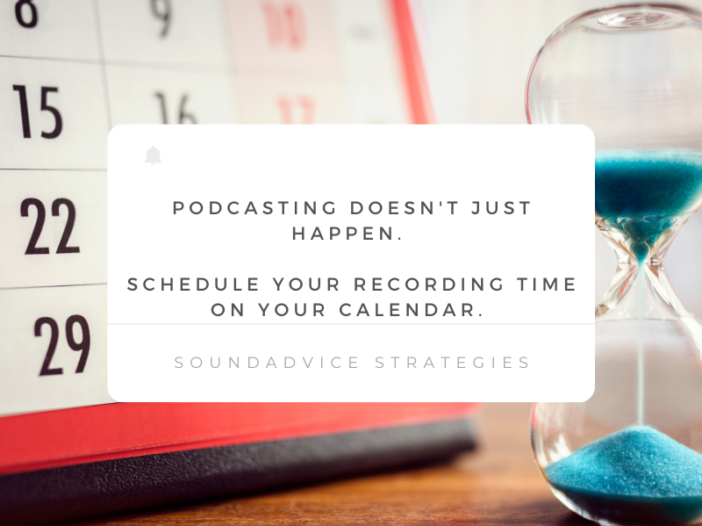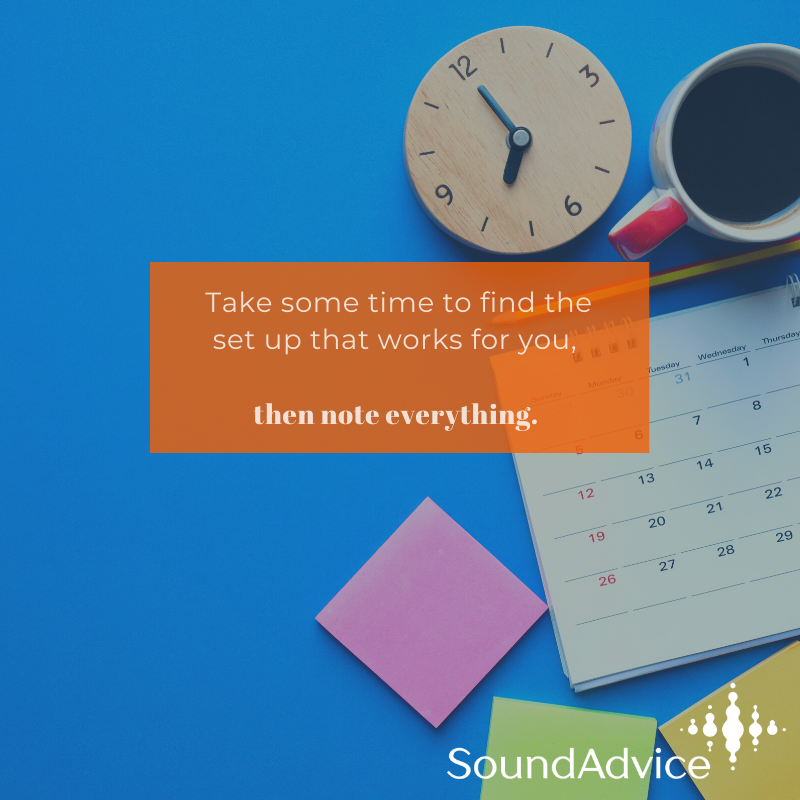
Working from home means my office does double duty as my podcast studio space. I’ve tried several microphones, stands, recorders, and software. With practice and the patience of my husband (and business partner) I’ve got a set up that works well for me.
I work in my office, at my desk about 70% of the time. It functions as a podcast studio an average of 2 hours a week. I usually batch recordings to be efficient with my time and because they just don’t get done without scheduling on the calendar for recording.
Can we talk about that for a minute?
Podcasting doesn’t just happen.
It takes a bit of planning. Do what works for you regarding time of day, frequency etc. but right now, pull up your calendar and block off an hour for planning and an hour for recording. Schedule it so it gets done.
I like to batch record when possible. There’s minimal set up when I’m in recording mode and when I’m not, it’s out of the way.
Work with what you have.
My office is a room filled with hard surfaces. To combat the echo, I put foam wedges in front of me. These came from the hospital when Kelvin had surgery years ago. They work great – and when I am not recording, they are stashed on a shelf under my desk.
If you don’t have hospital foam wedges (and I hope you’ve never need them) you can purchase a tabletop version but anything soft can work. I’ve seen people use pillows, couch cushions and even a blanket.
Some people record in a closet that’s filled with clothes. I’ve not resorted to doing that, but I hear it works well.
The Equipment
I use the MXL-BCD-1 microphone and it’s on an On-Stage MS7701TB Telescoping Microphone Boom Stand. The stand and mic are semi-permanent. I can swing it out of the way when I’m not recording plus it’s not taking up desk space, so it doesn’t count as clutter.
This microphone is moderately priced at $150. (I paid a bit less last year) and the stand is $35. A more robust stand may be in the works, but I’ll get into that in a minute.
I like this because it’s a condenser microphone. Here’s the science-y info about what that means. For me, it means good clear audio with a bit of resonance.
Set Up One – Multiple Person Recording Using Squadcast
For multi-person recording I use my laptop and Squadcast.
I plug the microphone into my Behringer Uphoria UMC 202HD. That is then plugged into the USB port of the laptop.
I know this may seem overly complicated, but it works and here’s why.
It gives me a consistent way to set up my recording including sound levels so it’s always the same.
I wear Skullcandy ear buds when I’m doing interviews and I also have headphones that I use now and then.
Set Up Two – Solo Recording
If I’m doing a solo recording, I use my Roland recorder. The recorder is so easy but it’s not something you need to purchase unless you want to be on the go or find yourself recording without your laptop. (My recorder is older, I linked to the newer version which looks a little different but works just the same)
I use notes when I record, and I like to print them out. Old school I know. I have a stand I use so they are stable and easy to see and I don’t have to shuffle them around. I used to make so much noise shuffling my notes even though I was trying to be so quiet!
Use digital notes on your phone or tablet if that’s your preference. The important thing is to make your set up work for you.
If you can record in the same place all the time AND keep things set up that’s ideal. Most of us can’t do that or choose not to for space concerns.

Take some time to find the set up that works for you, then note everything.
- What were your settings for volume?
- Exactly where is the microphone?
- Can you mark the spot in some way so it can always be put in the exact same spot? If not, take a photo of the ideal set up so you can easily re-create it.
- Do you sit or stand? Where is the mic stand? Mark the spot.
- Do you use foam sound shields? Make sure they are set up exactly where you need them.
- Headphones or earbuds? Wired or wireless? Find what works best for you and use it every time.
- Laptop or recorder? I use both and have recording settings pre-set so it’s always the same. When I use Squadcast, I do a quick sound check. My set up is the same so it doesn’t vary too much.
- Notes or script. Do you use your tablet or print off your notes? Make sure they are where you can see them without moving away from the microphone.
Test record so you can find the best set up for you.
Equipment and software options now make it easy to find what works for you in your space and on your budget.
If you’d like to get input on your ideal set up, you can sign up for a consultation with Kelvin who’ll gladly help you find the right resources that will work for you.
This consultation is part of our Podcast Launch Package along with a test-recording session. Our clients leave this meeting with the best recording set up or their personal and podcast style.
What set up questions can we answer for you? Let us know in the comments and we’ll make sure you get our #soundadvice.
